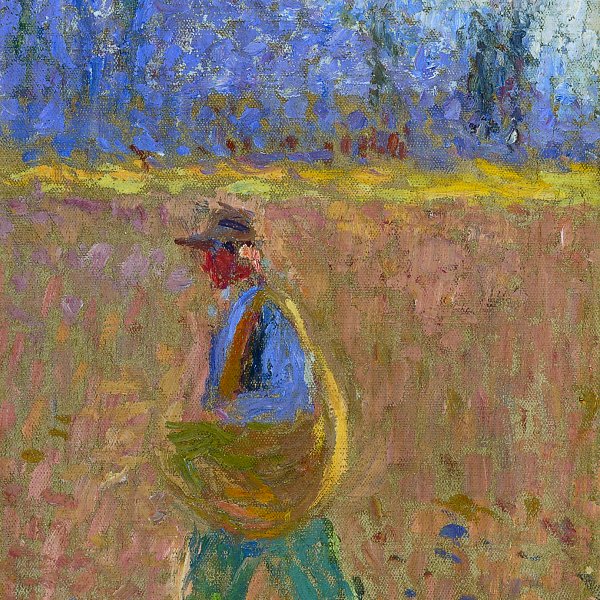Henri Martin
Henri Martin was born in Toulouse on 5 August 1860; his father was a cabinetmaker and his mother of Italian origin.
In 1877, after convincing his father with great difficulty, he enrolled in the École des Beaux-Arts in Toulouse, and studied with Jules Garipuy. Two years later he was awarded a prize and a scholarship that enabled him to join Jean-Paul Laurens's workshop at the École des Beaux-Arts in Paris.
While he was still a student of this institution, the State bought one of his paintings. In 1883 he was awarded a first class medal at the Salon for his painting Paolo Malatesta and Francesca di Rimini in Hell, and in 1885 he obtained a scholarship to travel to Italy, where he went in the company of Ernest Laurent and Aman Jean, and where apparently they met Seurat.
His espousal the theories of the Sâr Peladan and his participation in the salons of the Rosicrucians are evident in his symbolist works. Together with Puvis de Chavannes, among others, he decorated the Hotel de Ville in Paris with an Apollo and the Muses. In 1899 Puvis de Chavannes congratulated him on his Serenity. Besides these commissions, Martin executed easel paintings, intimate indoor scenes-where we can see his wife, his children and his friends-and some remarkable portraits made with pencil, pastels or oils.
The year 1900 marked a turning point in Henri Martin's career: he seems to have discovered colour and light, and to have mastered the most appropriate technique to render the latter. He bought Marquayrol's house in Labastide du Vert, in the department of Lot. That meant the end of his symbolist period, and the beginning of his large, luminous decorations, preceded by endless drawings and preparatory oils, for which he occasionally adopted pure colours and juxtaposed brushstrokes. Some examples of this style are: The Reapers, for the Capitole in Toulouse, and Labour for the Caisse d'Epargne in Marseille, of 1903, and the Banks of the Garonne, for the Capitole in Toulouse, of 1906.
In 1910, the Galerie Georges Petit in Paris organised a monographic exhibition of the artist. During the war, Martin began a new decoration on the recurrent theme of work for the Palais de Justice in Paris, and later The Working France Presenting Itself Before The Council of State, a commission which he did not finish until 1924.
He always kept himself close to power, in spite of his authoritative and independent character, and in 1917 Henri Martin was granted the title of commander of the Légion d'honneur, and was elected member of the Académie des Beaux-Arts.
In 1923, he bought a house at Collioure and painted many views of the port and the village, and large seascapes, which are a bright sequel to the dark sea views of Brittany from his early years.
At the request of his friend and fellow-citizen Anatole de Monzie, a minister at the time, in 1927 he painted The Grape Harvest for the grand staircase at the Prefecture in Cahors, followed by another triptych for the city of Cahors, commemorating the First World War, which was in fact a pretext to paint a gallery of portraits of all the people, close friends and relatives, who were dear to him.
In 1935, at the age of seventy-five, he began a final, large decoration destined to the council of the 5th arrondissement in Paris: The Luxembourg. That same year the museum of the Petit Palais organised a retrospective exhibition of his work. In 1939, Henri Martin retired to Labastide du Vert, where he died on 12 November.
Catherine Coustols





